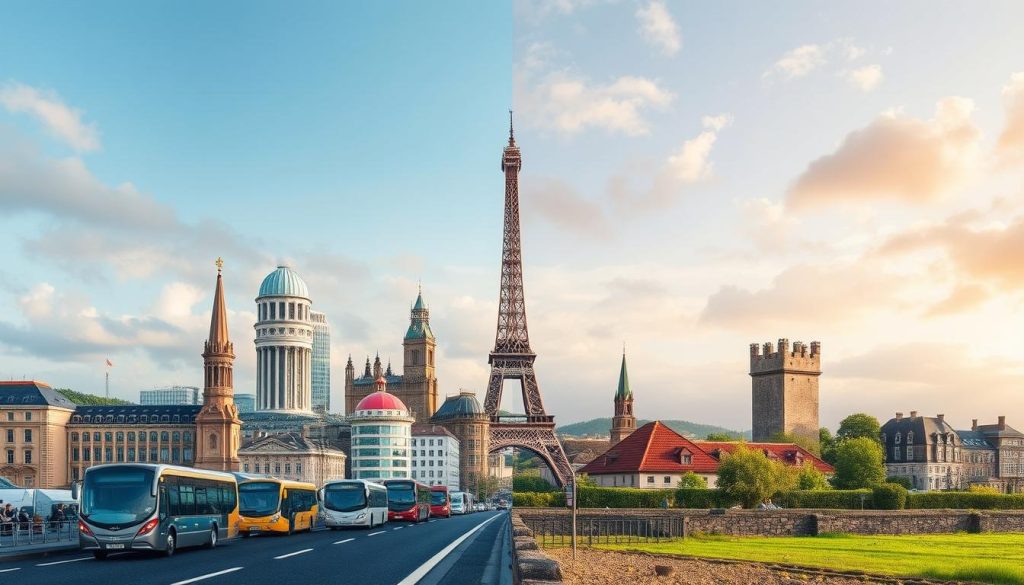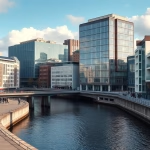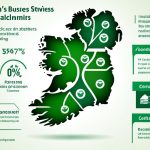In Ireland, transport costs vary widely between the city and countryside. This difference is a big issue for both those making policies and those travelling daily. We will look at why commuting costs differ between urban and rural areas. The main reasons include the layout of the land and the number of people living in each area. These factors affect things like the price of fuel and the choices for public transport.
- Overview of Transport Costs in Ireland
- Urban Transport Options
- Rural Transport Options
- Cost Analysis: Urban vs Rural Transport
- Accessibility and Convenience
- Environmental Impact of Urban and Rural Transport
- A Case Study: Dublin vs County Kerry
- How Does Income Affect Your Transport Choices?
- The Role of Government Policies on Transport Costs
- Transportation Costs Differ Between Urban and Rural Areas
- Future Trends in Urban and Rural Transport Costs
- Reducing Transport Costs: Tips for Urban Dwellers
- Reducing Transport Costs: Tips for Rural Dwellers
- FAQ
Key Takeaways
- Urban and rural regions in Ireland exhibit notable differences in transport costs.
- Fuel prices and public transport availability are significant contributors to these variations.
- Commuting expenses are influenced by geographic and demographic factors.
- Urban areas have more public transport options than rural regions.
- Transport costs impact the overall Irish transportation budget significantly.
Overview of Transport Costs in Ireland
It’s vital to know about transport costs in Ireland for city and countryside folks. Residents moving around in cities like Dublin or through quiet areas of County Kerry need this info. The main things that affect these costs are mostly the same everywhere.
Fuel prices greatly influence how much traveling costs in Ireland. The prices of petrol and diesel keep changing. This means how much money you need for travel can change a lot. Choosing cars that use less fuel helps save money, great for those who drive long distances.
Public transport prices change depending on what you take—buses, trams (like Dublin’s Luas), or trains (such as Iarnród Éireann). City people save money with monthly passes instead of buying tickets each time. However, in the countryside, there’s less public transport available, pushing people to use their own cars more.
Keeping a vehicle in good shape is key to managing transport costs in Ireland. Costs for regular check-ups, insurance, and sudden fixes can pile up. So, it’s smart to plan for these ongoing expenses.
Understanding these usual costs helps us learn more about how urban and rural transport works. Knowing about these important bits helps us see what makes travel in Ireland expensive. We can then look closer at the differences between city and country travel.
Urban Transport Options
Exploring urban transport in Ireland reveals many ways to get around the city. In busy places, finding efficient and affordable methods is vital. It enables residents to choose wisely for their daily travel needs.
Public Transport
Public transport in Ireland includes buses, trams, and trains. Companies like Dublin Bus and Irish Rail run them. They cover most urban areas well.
These networks are known for being pocket-friendly and eco-friendly. They are better than using private cars. Leap Cards make public transport even more attractive by offering cheaper fares.
Private Transport
Owning a car involves costs like fuel, insurance, and upkeep. Yet, many in Ireland like the convenience and freedom it offers. But ride-sharing apps like Uber and Free Now are becoming popular too.
They offer an easy and often cheaper way to travel in the city. This mixes the benefits of private transport with lesser costs.
Rural Transport Options
Exploring the countryside in Ireland shows a big difference in transport between cities and rural areas. The lack of public transport in the countryside means people rely a lot on their cars.
Public Transport
Public transport isn’t as good in rural areas. It doesn’t come as often and doesn’t go as many places as in the cities. This makes it hard for people living there to get around.
People in the countryside often wait a long time for a bus or train. The limited options make daily travel or emergencies challenging without a private vehicle.
Private Transport
Because public transport is rare, cars become essential in the countryside. But, owning a car is expensive. It costs a lot for fuel, upkeep, and insurance.
Cars are even more important because rural homes are spread out. Travelling far for basics like shopping can add to expenses. Changing fuel prices and high repair costs from long trips also affect these costs.
| Aspect | Urban Areas | Rural Areas |
|---|---|---|
| Public Transport Availability | High | Low |
| Personal Vehicle Dependency | Low to Medium | High |
| Personal Vehicle Expenses | Medium | High |
Cost Analysis: Urban vs Rural Transport
When we look at urban and rural transport costs in Ireland, we see big differences. These include fuel costs, vehicle maintenance, and public transport prices. They play a big role in how much we spend to travel in these settings. Let’s take a closer look at the costs involved.
Fuel Prices and Consumption
Urban and rural areas have different fuel costs and use. In cities, cars often use more fuel. This is because they stop and start a lot due to traffic jams. However, in the countryside, cars can go longer distances without stopping, which might save on fuel. This shows why city drivers should try to drive more efficiently.
Maintenance Expenses
The cost to keep a vehicle running also varies. In the city, cars go through more stress. For example, brake pads and clutches might need changing more often than in rural cars. Country vehicles have easier journeys which causes less wear. Also, country roads and weather can affect how often cars need care.
Public Transport Fares
Public transport prices also differ greatly between urban and rural areas. Cities like Dublin have many cheap public transport options. But, rural areas have fewer services, which can make each trip more expensive. This big difference can affect where people choose to live based on public transport costs.
| Comparative Aspect | Urban Transport | Rural Transport |
|---|---|---|
| Fuel Costs in Ireland | Higher due to traffic congestion | Lower, better fuel economy |
| Vehicle Maintenance Charges | Higher due to frequent wear and tear | Moderate, influenced by road quality |
| Public Transport Pricing | Lower with extensive connectivity | Higher due to limited options |
Accessibility and Convenience
How we get around greatly shapes our daily lives. It decides if we can easily get to places we need, like shops, hospitals, schools, or work. The type of transport available affects our choices on how we travel, no matter where we live.
Being able to travel easily is key. People living in cities might enjoy many public transport options. They can choose from different bus or train routes. But, in the countryside, folks often need their own car. This is because buses or trains are few and far between.
Thinking about the cost of getting around is key. Public transport might save money but can take longer and be less comfy. On the other hand, cars are comfy and flexible but cost more in fuel and upkeep.
Let’s look at city life versus country life in terms of getting around:
| Aspect | Urban | Rural |
|---|---|---|
| Public Transport Frequency | High | Low |
| Travel Time | Moderate | Variable |
| Access to Essential Services | Easy | Challenging |
| Cost of Travel | Lower | Higher |
Finding a good balance is a constant struggle. It’s about making sure everyone, city dwellers or country folk, can move around easily and affordably. Ensuring fair access to transport is crucial for everyone’s well-being.
Environmental Impact of Urban and Rural Transport
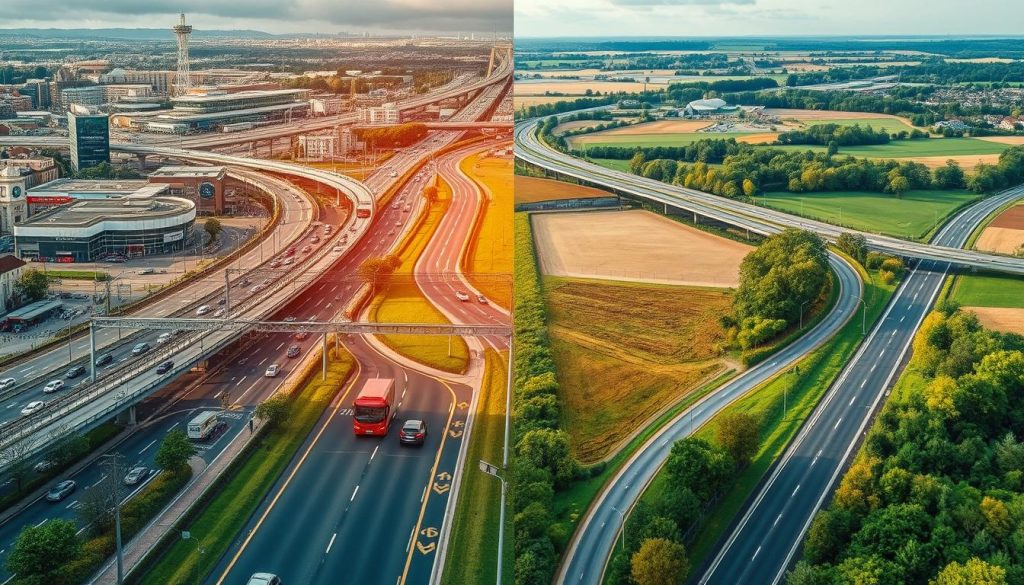
The environmental impact of transport in cities and countryside areas is quite different. This is because of how people travel, the setup of roads and public transport, and options for green travel. Looking into the environmental cost of transport shows us how travelling affects our environment. It also tells us how we can lessen these effects.
Urban Areas
In cities, where lots of people live close together, there’s a greater eco-impact of commuting. Cars, buses, and taxis pollute the air and add to climate change. But cities also offer more green alternatives. They have electric buses, bikes you can borrow, and good public transport. These options help make the city’s air cleaner.
Rural Areas
Rural areas, on the other hand, usually have cleaner air. They have fewer cars and less traffic jam. But the environmental cost of transport can still be high because of long drives and not many buses or trains. People in the countryside often need their cars, which means they might pollute more per person. To make things better, we can suggest sharing rides, improving buses, and encouraging electric cars.
| Region | Main Transport Mode | Emissions | Eco-Friendly Alternatives |
|---|---|---|---|
| Urban Areas | Public Transport, Cars | Higher | Electric Buses, Bicycle Sharing |
| Rural Areas | Private Vehicles | Lower (per capita) | Carpooling, Electric Vehicles |
A Case Study: Dublin vs County Kerry
Comparing Dublin transport costs with Kerry rural commuting shows the vast differences in Ireland’s travel costs. This study looks at many factors that affect urban and rural areas. It points out the big differences in travel in Dublin, the capital, and rural County Kerry.
In Dublin, there’s a lot of public transport which helps cut costs for people living there. The city has many buses and trains that are easy to use, with good prices and frequent times. In Kerry, however, there’s not much public transport. People mostly have to use their own cars. This means they spend more on petrol and keeping their car running.
The prices for public transport also vary a lot between Dublin and Kerry. Dubliners have access to smart ticketing and discounts if they travel often. In Kerry, with less public transport available, there aren’t as many options for saving money. This shows that different plans are needed to help rural travellers and make transport fair all over Ireland.
Looking at these differences in an Ireland travel expenses case study shows how important it is to create policies for both city and rural areas. By finding a balance, Ireland can make travel costs fairer. Whether it’s in the busy streets of Dublin or the peaceful lanes of Kerry, everyone needs affordable travel options.
How Does Income Affect Your Transport Choices?
Income levels play a big part in how people in Ireland get around. If you earn more, you usually have more choices and might buy a car. But if your budget is tight, you’ll likely use buses or trains more. It’s really important to understand these choices to make better transport policies.
People with more money can often use fancy services like taxis or ride-sharing. However, these might be too expensive for those earning less. It’s interesting to see how money affects transport options.
Looking closely at money and travel in Ireland shows us a lot. It’s clear that your income affects how often you travel, how far you go, and what transport you use. Here are some key differences:
| Income Bracket | Preferred Transport Mode | Accessibility to Premium Services |
|---|---|---|
| Low | Public Transport | Limited |
| Medium | Mix of Public and Private | Moderate |
| High | Private Vehicles | High |
So, money and getting around in Ireland are closely linked. Income greatly shapes how we choose to travel. We need policies that consider everyone’s needs. They should give equal transport chances to all, regardless of income. By including these income-based decisions in planning, we can make transport fair for everyone.
The Role of Government Policies on Transport Costs
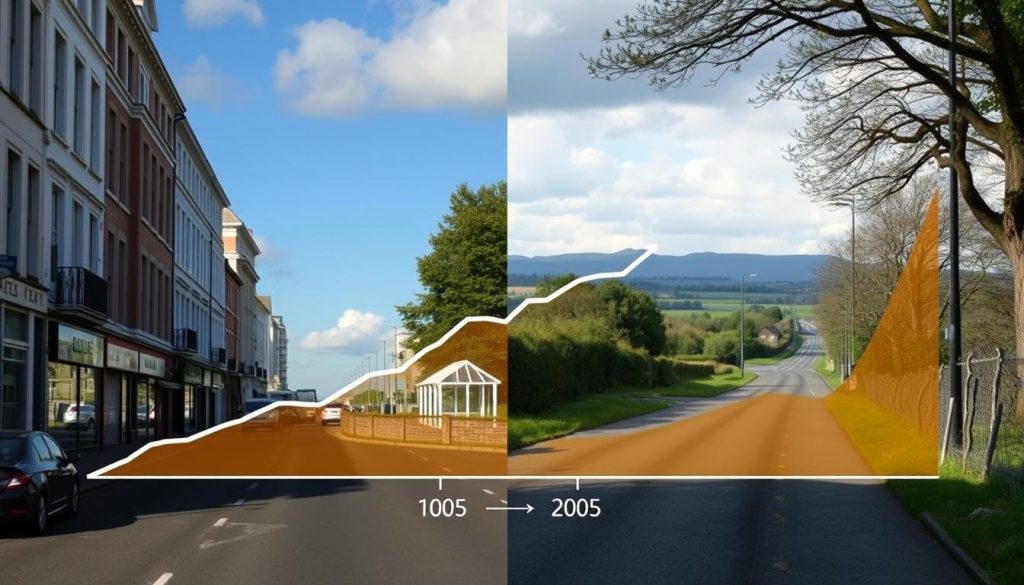
In Ireland, government action significantly affects the cost of travel, shaping how people spend money on getting around. The country’s transport policies aim to make travel affordable while being kind to the planet.
One way the government helps is by lowering public transport prices through subsidies. This makes it easier for everyone, in cities and the countryside, to use buses and trains. However, how much help you get can depend on where you live and the government’s budget.
Taxes on cars are another tool used by the authorities. By taxing cars, the government manages the number of cars on our roads. This helps make travel costs fairer. In cities, for example, owning a car can cost more. This encourages people to choose greener ways to commute.
In addition, there are rewards for choosing eco-friendly travel options. Benefits like money off when buying electric cars or help setting up charging points are examples. These efforts aim to cut down pollution and make getting around cheaper in the future.
How these policies play out can differ depending on where you live. In cities, you’re likely to see more schemes that aim to lessen traffic and clean the air. But in the countryside, the focus might be more on making sure people can reach places they need to go, despite the distances.
| Government Policy | Impact on Urban Areas | Impact on Rural Areas |
|---|---|---|
| Subsidised Fares | Reduces daily commuting costs | Improves access to distant services |
| Vehicle Taxation | Encourages use of public transport | Increases cost for farmers and long-distance drivers |
| Eco-friendly Commuting Incentives | Promotes electric vehicle use | Supports installations of charging stations in remote areas |
Transportation Costs Differ Between Urban and Rural Areas
In Ireland, transport costs differ a lot between cities and the countryside. This happens due to infrastructure quality, available services, and prices that change from one region to another.
Understanding Regional Price Variations
In big cities like Dublin, lots of buses and trains make it cheaper for everyone. But in these places, parking and extra fees for driving can increase what you spend. So, cities can be pricey because of these costs.
Infrastructure and Availability
In the countryside, few buses or trains mean people need their cars more. This shows how important good transport services are for keeping costs down. In cities, having many transport options means you might not need a car. This can save you money.
| Factor | Urban Areas | Rural Areas |
|---|---|---|
| Public Transport Availability | High | Low |
| Car Ownership Necessity | Low | High |
| Parking Fees | High | Low |
| Congestion Charges | Present | Absent |
To sum up, the type of area and price differences impact transport costs a lot. Understanding these can help us tackle the cost issues in Ireland’s different regions.
Future Trends in Urban and Rural Transport Costs
In Ireland, transport costs are changing due to new technologies and changes in society. Electric vehicles (EVs), which are getting cheaper and better, will play a big role. This means lower costs for fuel and looking after cars, both in cities and the countryside.
Better public transport will also affect costs. In cities, more buses and metro lines, plus new ways to pay, will make travel cheaper. In the countryside, better bus services and schemes for the community will make travel less expensive per mile.
These improvements point to cheaper, eco-friendlier travel choices. The government will help by making policies that encourage using EVs and improving public transport. This should lessen the cost of getting around for everyone.
Also, changes in fuel prices will change transport costs. As we use more renewable energy, fuel costs might become lower and more stable. This will help make the cost of travelling more predictable for all. But, it’ll need a lot of planning and investment at first.
| Urban Trends | Rural Trends |
|---|---|
| Expansion of metro and bus networks | Investment in reliable bus services |
| Adoption of electric vehicles | Community transport schemes |
| Digital payment systems for public transport | Subsidised EV ownership |
| Stable or reduced fuel costs | Stabilized fuel pricing through renewables |
Reducing Transport Costs: Tips for Urban Dwellers
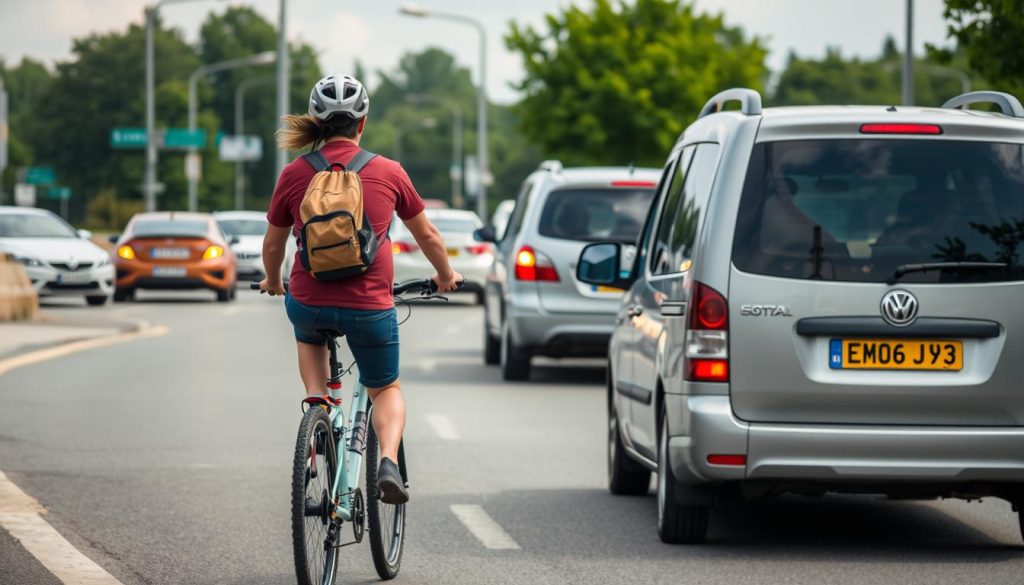
People living in cities often spend more on getting around. But, there are smart ways to lower these costs. Using public transport, sharing rides, and choosing cars that use less fuel can help save a lot of money.
Utilise Public Transport
Public transport is a great way to cut travel costs in the city. Places like London and Dublin have great public transport services. They are cheaper than driving and you won’t have to deal with traffic. This means spending less on fuel, parking, and car upkeep.
- Buy multi-ride passes or season tickets to save even more.
- Use apps and timetables to plan your trips well.
- Look for cheaper off-peak travel fares.
Opt for Carpooling
Carpooling is good for your wallet and the planet. By sharing rides, you can reduce your travel costs significantly. Websites like BlaBlaCar and Liftshare make it easy to find people to carpool with.
- Share the costs of fuel and tolls with your passengers.
- Less driving means less wear on your car.
- It helps cut down on traffic and air pollution in cities.
Invest in Fuel-Efficient Vehicles
Choosing a car that doesn’t use much fuel is smart if you prefer driving. Cars like the Toyota Prius or Hyundai Ioniq are good choices. They use less fuel and pollute less, saving you money in the long run.
| Vehicle Model | Fuel Efficiency (MPG) | Estimated Annual Savings |
|---|---|---|
| Toyota Prius | 58 | £500 |
| Hyundai Ioniq | 55 | £480 |
Following these tips can ease the financial strain for city residents. It also helps make our cities greener and more sustainable.
Reducing Transport Costs: Tips for Rural Dwellers
For those living in the countryside, using community transport schemes is key. These schemes offer shared rides for much less than solo driving. Look into local groups that help with travel. By joining these networks, countryside folk can cut down on travel costs a lot.
Planning your travel smartly is also crucial for saving money. Try to do several errands in one trip to use less fuel and reduce wear on your car. This planning can help you avoid busy roads, saving time and money. Stay updated on road conditions and events that might affect your journey.
Thanks to remote work, many living in rural areas needn’t commute every day. Working from home saves money on travel and improves work-life balance. More employers now support flexible work arrangements. Think about how remote working could work for you and talk to your boss about it.

